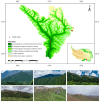Leaf Functional Traits and Their Influencing Factors in Six Typical Vegetation Communities
- PMID: 39273907
- PMCID: PMC11397209
- DOI: 10.3390/plants13172423
Leaf Functional Traits and Their Influencing Factors in Six Typical Vegetation Communities
Abstract
Leaf functional traits (LFTs) have become a popular topic in ecological research in recent years. Here, we measured eight LFTs, namely leaf area (LA), specific leaf area (SLA), leaf thickness (LT), leaf dry matter content (LDMC), leaf carbon content (LCC), leaf nitrogen content (LNC), leaf phosphorus content (LPC), and leaf potassium content (LKC), in six typical vegetation communities (sclerophyllous evergreen broad-leaved forests, temperate evergreen coniferous forests, cold-temperate evergreen coniferous forests, alpine deciduous broad-leaved shrubs, alpine meadows, and alpine scree sparse vegetation) in the Chayu River Basin, southeastern Qinghai-Tibet Plateau. Our aim was to explore their relationships with evolutionary history and environmental factors by combining the RLQ and the fourth-corner method, and the method of testing phylogenetic signal. The results showed that (i) there were significant differences in the eight LFTs among the six vegetation communities; (ii) the K values of the eight LFTs were less than 1; and (iii) except for LCC, all other LFTs were more sensitive to environmental changes. Among these traits, LA was the most affected by the environmental factors, followed by LNC. It showed that the LFTs in the study were minimally influenced by phylogenetic development but significantly by environmental changes. This study further verified the ecological adaptability of plants to changes in environmental factors and provides a scientific basis for predicting the distribution and diffusion direction of plants under global change conditions.
Keywords: RLQ analysis; environmental factors; leaf functional traits; phylogenetic signals.
Conflict of interest statement
The authors declare no conflicts of interest.
Figures






References
-
- Ma J., Wang T., Wang H., Yang J., Xie T., Zhang Z., He C., Shan L. Variation and Correlation among Fine Root Traits of Desert Plants in Arid Areas of Northwest China. Forests. 2024;15:476. doi: 10.3390/f15030476. - DOI
-
- Luo W., Valverde-Barrantes O.J., Weemstra M., Cahill J.F., Jr., Wang Z., He D., Chen Y., Chu C., Wang Y. Leaf and root traits are partially coordinated but they show contrasting multi-trait-based community trait dispersion patterns in a subtropical forest. J. Plant Ecol. 2024;17:rtad045. doi: 10.1093/jpe/rtad045. - DOI
-
- Huxley J.D., White C.T., Humphries H.C., Weber S.E., Spasojevic M.J. Plant functional traits are dynamic predictors of ecosystem functioning in variable environments. J. Ecol. 2023;111:2597–2613. doi: 10.1111/1365-2745.14197. - DOI
-
- Liu H., Yin D., He P., Cadotte M.W., Ye Q. Linking plant functional traits to biodiversity under environmental change. Biol. Divers. 2024;1:22–28. doi: 10.1002/bod2.12004. - DOI
Grants and funding
- 2021FY100201/Special Foundation for National Science and Technology Basic Research Program of China
- 2019QZKK05020110/Second Tibetan Plateau Scientific Expedition and Research Program
- YJS2023-02/Graduate Innovation Program Funding Project YJS2023-02 of Xizang Agricultural and Animal HusbandryUniversity
LinkOut - more resources
Full Text Sources

